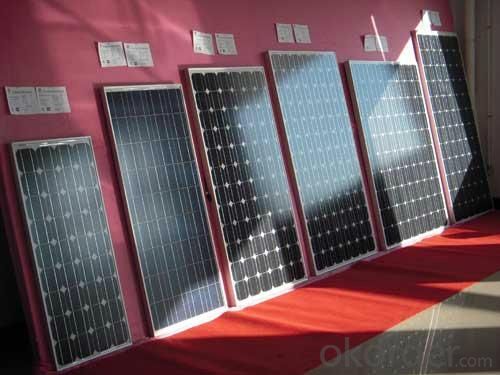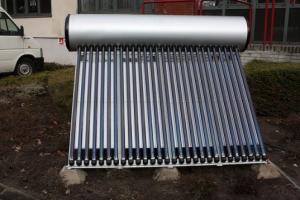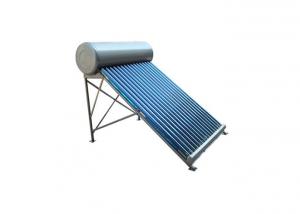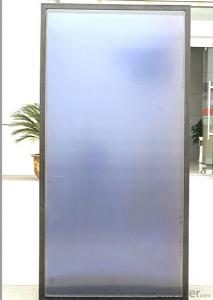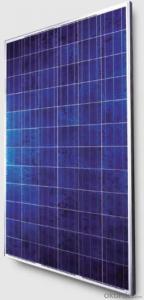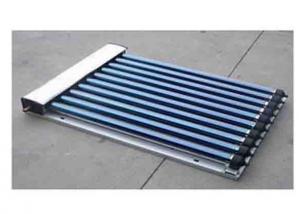Made in China Polycrystalline Solar Modules with Vacuum Tube Solar Collectors
- Loading Port:
- Tianjin
- Payment Terms:
- TT OR LC
- Min Order Qty:
- 1 pallet
- Supply Capability:
- 100000000 pallet/month
OKorder Service Pledge
OKorder Financial Service
You Might Also Like
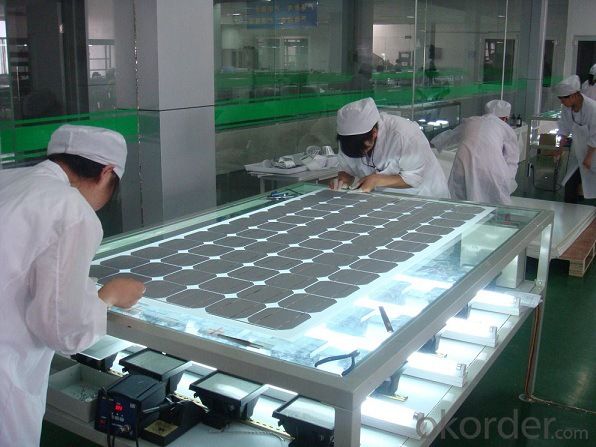
Specifications:
solar panels from 5W--300W, made of TAIWAN MOTECH brand cells,with CO in TAIWAN,Mono and Poly with VDE,IEC,CSA,UL,CE,ISO.
We import solar cells from Taiwan Motech brand, with this CO in taiwan and our CSA certification,we can still sell goods to Anti-dumping areas like USA. Our main products are solar panels, off grid and on grid solar home systems , solar street lighting systems, solar water heating system,solar pump,solar attic fan, solar DC LED lights and solar DC refrigerators.
Certificates : ISO, CE, VDE IEC, MCS, CSA-UL, CEC.
Delivery time: sample 10days, order 25-30days.
Sample: charged.
Payment term: T/T 30% as deposit, 70% before shipment. Or irrevocable L/C at sight.
Trade term: FOB Shenzhen or CIF destination seaport or Airport.
Characteristics:
I.Solar Cell : High efficiency crystalline solar cell. Even if under the weak light, the solar module can produce maximum power output.
II.Tempered glass (toughened glass): Anti-reflecting coating and high transmission rate glass increase the power output and mechanical strength of solar module.
III.EVA and TPT: Using high quality EVA and TPT to prevent destroying and water.
IV.AI frame: Without screw, corner connection. 6 holes on the frame can be installed easily.
V.Junction box: Multi function junction box with water proof.
VI.Long lifetime: ≥25 years; Less power decrease.
VII.Good performance of preventing from atrocious weather such as wind and hails.
VIII.Resisting moisture and etching effectively, not effected by geology.
IX.The certificate issued by international authority: UL, TUV, IEC, VDE, CE.
Quality and Safety
1. Rigorous quality control meets the highest international standards.
2. High-transmissivity low-iron tempered glass, strong aluminium frame.
3. Using UV-resistant silicon.
4. IS09001/14001/CE/TUV/UL
Warranties
1. 10 years limited product warranty
2. 15 years at 90% of the minimal rated power output
3. 25 years at 80% of the minimal rated power output
Technical date :
ITEM NO.: | Poly 156*156 cell ,60pcs . Power range from 230Wp-260Wp | ||||||
Maximum Power(W) | 230 | 235 | 240 | 245 | 250 | 255 | 260 |
Optimum Power Voltage(Vmp) | 29.4 | 29.5 | 29.7 | 30.1 | 30.3 | 30.5 | 30.7 |
Optimum Operatige Current(Imp) | 7.83 | 7.97 | 8.08 | 8.14 | 8.25 | 8.37 | 8.48 |
Open Circuit Voltage(Voc) | 36.7 | 36.8 | 36.9 | 37.1 | 37.3 | 37.5 | 37.7 |
Short Circuit Current(Isc) | 8.52 | 8.59 | 8.62 | 8.65 | 8.69 | 8.73 | 8.78 |
Solar Cell: | 156*156 Poly | ||||||
Number of Cell(pcs) | 6*10 | ||||||
Name of Solar Cells | Polycrystalline Cell | ||||||
Size of Module(mm) | 1650*992*40/45/50 | ||||||
Cable & Connector Type | Pass the TUV Certificate | ||||||
Frame(Material Corners,etc.) | Aluminium-alloy | ||||||
Back sheet | TPT | ||||||
Weight Per Piece(KG) | 19.5KG | ||||||
FF (%) | 70-76% | ||||||
Junction Box Type | Pass the TUV Certificate | ||||||
Tolerance Wattage(e.g.+/-5%) | ±3%, or 0-3% | ||||||
Front Glass Thickness(mm) | 3.2 | ||||||
Temperature Coefficients of Isc(%) | +0.04 | ||||||
Temperature Coefficients of Voc(%) | -0.38 | ||||||
Temperature Coefficients of Pm(%) | -0.47 | ||||||
Temperature Coefficients of Im(%) | +0.04 | ||||||
Temperature Coefficients of Vm(%) | -0.38 | ||||||
Temperature Range | -40°C to +85°C | ||||||
Surface Maximum Load Capacity | 5400Pa | ||||||
Allowable Hail Load | 23m/s ,7.53g | ||||||
Bypass Diode Rating(A) | 12 | ||||||
Warranty | 90% of 10 years, 80% of 25 years. | ||||||
Standard Test Conditions | AM1.5 1000W/ 25 +/-2°C | ||||||
Packing | carton or pallet | ||||||
1*20' | 14 Pallets / 316pcs | ||||||
1*40'STD | 25 Pallets / 700pcs | ||||||
FAQ:
I..Will you focus on the safety of the goods during transportation?
Yes, Safety of the cargo is the primary element that we would consider on transportation.
II..How would guarantee the quality will meet the requirements of your clients?
Before shipment, we will have inspection for each batch of goods.
III..What certificates do you have?
IEC,UL,TUV,CSA,etc.
IV..Can you do OEM according to clients’ requirements?
Yes, we have our own brand while we can provide OEM service.
- Q: Can solar collectors be used for air conditioning?
- Yes, solar collectors can be used for air conditioning. Solar thermal systems can convert sunlight into heat energy, which can then be used to power absorption chillers or heat pumps for cooling purposes. This allows for more sustainable and energy-efficient air conditioning solutions.
- Q: Can solar collectors be used for heating train stations and public transportation terminals?
- Yes, solar collectors can indeed be used for heating train stations and public transportation terminals. By harnessing solar energy, these collectors can provide a sustainable and renewable source of heat to these facilities, reducing their dependence on traditional energy sources and lowering their carbon footprint. Additionally, the use of solar collectors can result in cost savings and contribute to a more environmentally friendly transportation system.
- Q: Can solar collectors be used for drying clothes?
- Yes, solar collectors can be used for drying clothes. Solar collectors, such as solar panels or solar air heaters, can generate heat from the sun, which can be used to dry clothes naturally without the need for electricity or gas-powered dryers. This method is energy-efficient and environmentally-friendly.
- Q: Are solar collectors suitable for heating schools and universities?
- Yes, solar collectors are suitable for heating schools and universities. They are highly efficient in capturing sunlight and converting it into usable heat energy. Solar heating systems can be installed on rooftops or in open spaces, providing a cost-effective and sustainable solution for heating large educational institutions. Additionally, using solar energy reduces reliance on fossil fuels, helping to reduce carbon emissions and promote environmental sustainability.
- Q: Can solar collectors be used for industrial process heat?
- Yes, solar collectors can be used for industrial process heat. Solar thermal systems that use collectors to capture the sun's energy can provide heat for various industrial processes, such as heating water or fluids, powering steam generators, or supporting drying and heating operations. These systems can help reduce reliance on fossil fuels, decrease greenhouse gas emissions, and provide a sustainable and cost-effective source of heat for industrial applications.
- Q: Can solar collectors be used for heating car rental facilities?
- Yes, solar collectors can be used for heating car rental facilities. Solar collectors can generate heat by converting sunlight into thermal energy, which can be used to warm the air or water in the facilities. This can help reduce energy costs and carbon emissions associated with traditional heating systems.
- Q: Can solar collectors be used for generating electricity during cloudy days?
- Yes, solar collectors can still generate electricity during cloudy days, although the efficiency and power output may be reduced compared to clear sunny days.
- Q: Can solar collectors be used to heat water?
- Water can indeed be heated using solar collectors. These collectors, also known as solar thermal panels, are specifically designed to capture the energy from the sun and convert it into heat. Their installation usually takes place on rooftops or other suitable locations where they can receive maximum exposure to sunlight. The composition of these solar collectors consists of a series of tubes or plates that are purposely designed to absorb the sun's rays. To enhance their efficiency in capturing solar energy, these tubes or plates are often coated with a material that absorbs heat, such as black paint or a selective coating. When the collector is struck by the sun's rays, the heat is then transferred to a fluid flowing through these tubes or plates. This fluid, typically a mixture of water and an antifreeze solution, absorbs the heat and is subsequently pumped into a storage tank. The heated fluid then transfers its heat to the water present in the storage tank, thus increasing its temperature. Solar collectors can be employed in various types of water heating systems, including those used for domestic hot water and swimming pool heaters. In the case of domestic hot water systems, the solar collectors are responsible for heating the water used for showers, sinks, and other household purposes. As for swimming pool heaters, the solar collectors warm the water in the pool, allowing for comfortable swimming even during colder months. The use of solar collectors for water heating brings forth several advantages. Firstly, it relies on renewable energy sources, reducing the dependence on fossil fuels and subsequently lowering carbon emissions. Secondly, it has the potential to significantly reduce energy costs, considering sunlight is readily available and free of charge. Lastly, solar collectors boast a long lifespan and require minimal maintenance, making them a cost-effective and sustainable choice for water heating.
- Q: What is the typical warranty period for solar collectors?
- The typical warranty period for solar collectors can vary depending on the manufacturer and the specific type of solar collector being used. However, in general, most reputable solar collector manufacturers offer warranties ranging from 10 to 25 years. These warranties typically cover defects in materials and workmanship, as well as performance guarantees. It is important to carefully review the warranty terms and conditions before purchasing solar collectors to ensure that they meet your specific needs and expectations. Additionally, it is recommended to choose solar collectors from reputable manufacturers with a proven track record in the industry, as this can help ensure the warranty is honored and any potential issues are addressed promptly.
- Q: Can solar collectors be used for generating electricity on mines?
- Yes, solar collectors can be used for generating electricity on mines. Solar collectors, also known as solar panels or photovoltaic (PV) panels, convert sunlight into electricity through the photovoltaic effect. They are designed to capture and convert solar energy into electrical energy. Mines often require a significant amount of electricity to power their operations, including machinery, lighting, ventilation systems, and other equipment. Solar collectors can be installed on the roofs or open spaces of mine buildings or structures to harness the abundant sunlight available in many regions. The electricity generated by the solar panels can then be used to directly power the mine's operations, reducing the reliance on traditional sources of energy such as fossil fuels. Implementing solar collectors on mines has several benefits. Firstly, it can significantly reduce the mine's carbon footprint and environmental impact by replacing fossil fuel-based electricity generation with clean and renewable solar energy. This contributes to the global efforts in combating climate change and reducing greenhouse gas emissions. Secondly, solar collectors can help mines reduce their energy costs in the long run. Although the initial investment in installing solar panels can be substantial, the operational and maintenance costs associated with solar energy are relatively low compared to traditional energy sources. Over time, the savings in electricity bills can offset the initial investment, resulting in cost-effective energy generation for mines. Furthermore, solar collectors can provide a reliable and uninterrupted source of electricity for mines, especially in remote areas where access to the electricity grid might be limited or unreliable. By generating their own electricity, mines can ensure a continuous power supply for their operations, avoiding downtime and increasing productivity. It is worth mentioning that the feasibility and effectiveness of using solar collectors on mines may depend on various factors, such as the location, climate, available space, and energy requirements of the mine. Additionally, a comprehensive analysis of the mine's energy needs, potential solar energy generation, and the financial implications should be conducted before implementing solar collectors. Nonetheless, solar collectors have proven to be a viable and sustainable option for generating electricity on mines, offering numerous environmental and economic benefits.
Send your message to us
Made in China Polycrystalline Solar Modules with Vacuum Tube Solar Collectors
- Loading Port:
- Tianjin
- Payment Terms:
- TT OR LC
- Min Order Qty:
- 1 pallet
- Supply Capability:
- 100000000 pallet/month
OKorder Service Pledge
OKorder Financial Service
Similar products
Hot products
Hot Searches



